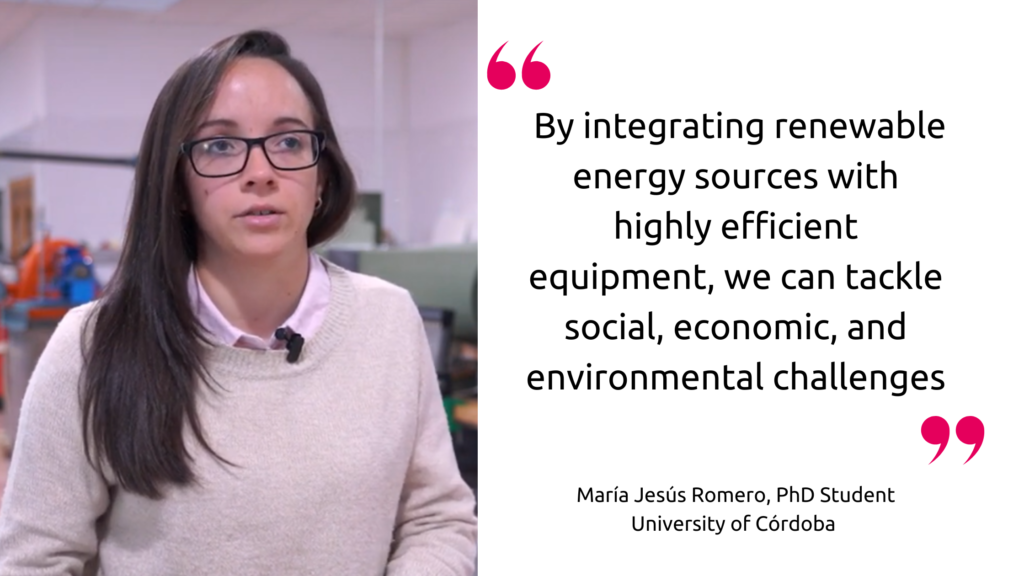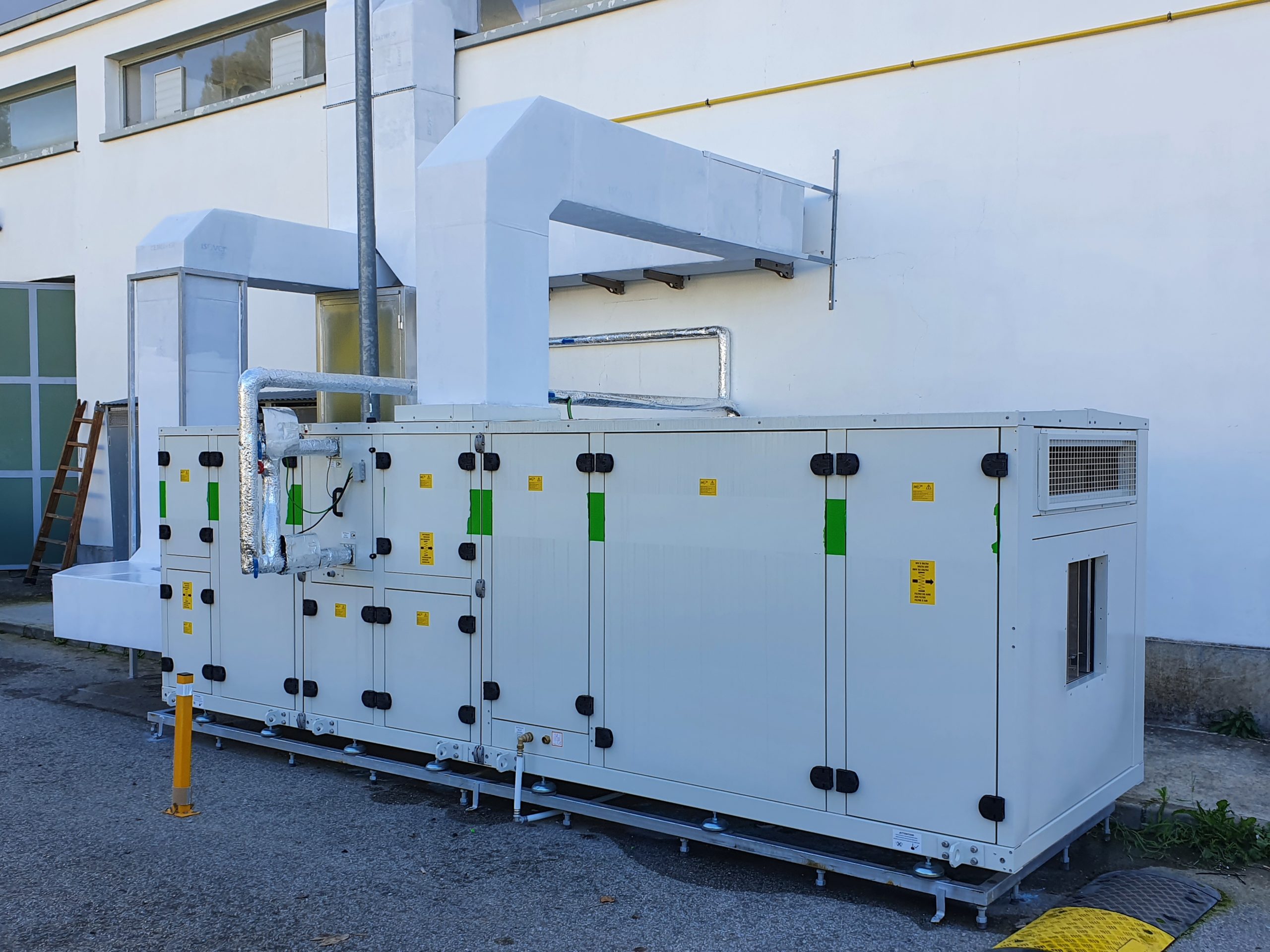
María Jesús Romero, a second-year PhD student at the University of Córdoba, is involved in the development and testing of the RACU (renewable air-cooling unit) prototype as part of her doctoral thesis within the WEDISTRICT project. She tells ESCI how the RACU presents an efficient and sustainable solution to address the challenges posed by increasingly severe climate conditions.
ESCI: Spain has been severely impacted by heatwaves and extreme temperatures in recent years. In the face of increasingly severe climate conditions and rising temperatures, what specific challenges arise in meeting the demand for cooling in Spain?
María Jesús Romero: Spain experiences severe summer weather with very high temperatures, particularly in the southern regions like Córdoba, where the University, and, of course, the Rabanales campus are located. To combat these conditions, we require efficient alternatives such as renewable energies and high-capacity cooling systems. As climate conditions worsen and temperatures rise, the demand for cooling increases. Therefore, we need energy-efficient equipment with significant cooling capacity to ensure thermal comfort. Additionally, proper ventilation is crucial for maintaining indoor air quality, especially considering disease transmission, as shown by the pandemic. By combining renewable energy sources with the RACU technology, we can effectively address these challenges. Since there is very high solar radiation in the south of Spain, we will use solar energy technology, such as as solar collectors and photovoltaic panels, in the Córdoba demonstrator.
ESCI: Can you explain what the RACU is and how it functions?
María Jesús Romero: The RACU prototype is a hybrid air cooling system that combines two innovative technologies and works exclusively with outside air. First, the outside air enters the device and passes through a desiccant wheel. This desiccant wheel removes excess moisture from the air, allowing us to control the humidity of the supplied air. Then, the air goes through a dew-point evaporative cooler, which cools down the air that will be supplied to the building. This technology offers robust control over humidity, temperature, and ventilation, making it superior to traditional equipments, which only control temperature. Additionally, the RACU can be integrated into district networks and utilize renewable thermal energy.
ESCI: What ongoing research and development efforts are being undertaken to explore the potential applications of the RACU prototype?
María Jesús Romero: Currently, we are conducting research on the RACU prototype and its potential applications. Our goal is to apply this prototype to real-world scenarios, such as cooling classrooms, so we must test it under a wide range of conditions. For that, we use air treatment units to condition the incoming air, manipulating factors like temperature and humidity. So far, the RACU has shown exceptional potential in terms of performance and energy efficiency, which opens up new avenues for research and development in terms of its application in other buildings with different purposes. Specifically, with the demonstration site here in Córdoba we want to explore the integration of the RACU with a renewable district network. The RACU could utilize the hot water piping network required for its wheel, and as it is located near a student building, it could be connected to one of the sections.

ESCI: How does your technology address the pressing issues of renewable energy, climate change, and rising energy costs?
María Jesús Romero: Our technology aims to tackle these issues by integrating highly efficient and sustainable solutions. While our current prototype at the University of Córdoba uses a boiler to increase the temperature of the water entering the desiccation wheel, we are focused on addressing the topics of renewable energy and climate change. We recognize the importance of reducing energy costs associated with climate control in buildings, which continue to rise due to more severe climate conditions. By combining our efficient technology and its strong cooling capacity with renewable sources, we believe we can provide a sustainable solution. This solution not only maintains thermal comfort and improves indoor air quality, but also takes into account the financial aspect, making it a comprehensive approach to addressing these pressing concerns.
ESCI: Traditional air conditioning systems seem less effective at cooling when temperatures are very high, and energy costs and carbon footprint become significant concerns. How do you think your technology can help overcome these challenges?
María Jesús Romero: The RACU prototype provides a significant advantage over traditional air conditioning systems. While traditional equipment’s cooling capacity decreases at higher outside temperatures, the RACU’s cooling capacity actually increases. For example, during a heatwave in Córdoba last year, with outside temperatures reaching 43-44°C, the RACU was able to cool the air to 17°C . Traditional equipment would struggle to achieve this level of cooling. The RACU’s efficiency remains high even in high-temperature conditions, resulting in lower energy consumption. This technology, when combined with renewable energy sources, offers a sustainable solution to combat climate change. It not only ensures thermal comfort but also reduces CO2 emissions, which are harmful contributors to climate change.
ESCI: Do you believe the demonstration site can be scaled up and extended within your community?
María Jesús Romero: The installation planned for the Rabanales campus at the University of Córdoba aims to cover the cooling and heating needs of the Leonardo da Vinci building, which houses student sections, professors’ offices, and research labs, and also to provide hot water to a dressing room in a sports stadium on the campus. While the initial plan covers these specific areas, it would be fantastic to extend the network to include other buildings with different uses, such as climatized swimming pool. This would allow us to study the effects of a renewable district network, fully powered by renewable energy for cooling and heating, in various contexts and structures with different uses. The network is also intended to be an interesting energy model to be used in some neighbourhoods in Córdoba city and other Southern cities in Europe. By conducting additional tests and obtaining experimental results, we can confirm the viability and benefits of implementing these sustainable district networks to address climate change, adverse summer conditions, and maintain thermal comfort during winter.
ESCI: What inspired you to join this project, and what do you think its impacts will be for society?
María Jesús Romero: When I was offered the opportunity to work on WEDISTRICT, I immediately recognized it as a truly interesting and beautiful project with potential for real-world impact. This project shows that engineering can address pressing issues that affect society. Climate change is a critical concern, and integrating this project with my PhD thesis was an easy decision. Through the development of 100% renewable district networks, we aim to improve people’s quality of life and offer sustainable and efficient heating and cooling solutions. Our demonstration sites serve as practical evidence that these networks are not just theoretical concepts, but viable and effective solutions. By integrating renewable energy sources with highly efficient equipment, we can tackle social, economic, and environmental challenges. This purpose and the opportunity to make a difference in the way of life of society increases the motivation of our team.
Read more about the RACU in the Córdoba demonstration site brochure.
ESCI: Thank you for this interview!